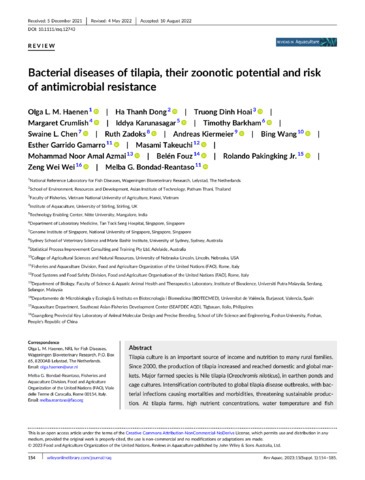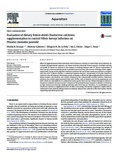Level and percentage recovery of resistance to oxytetracycline and oxolinic acid of bacteria from shrimp ponds
Share
| dc.contributor.author | Tendencia, Eleonor | |
| dc.contributor.author | de la Peña, Leobert D. | |
| dc.date.accessioned | 2014-03-24T08:34:07Z | |
| dc.date.available | 2014-03-24T08:34:07Z | |
| dc.date.issued | 2002 | |
| dc.identifier.citation | Tendencia, E. A., & dela Peña, L. D. (2002). Level and percentage recovery of resistance to oxytetracycline and oxolinic acid of bacteria from shrimp ponds. Aquaculture, 213(1-4), 1-13. | en |
| dc.identifier.issn | 0044-8486 | |
| dc.identifier.uri | http://hdl.handle.net/10862/1948 | |
| dc.description.abstract | The bacterial level of the water, sediment and cultured shrimp (Penaeus monodon) from different ponds were determined using a general medium, a presumptive Vibrio medium and a presumptive Pseudomonas–Aeromonas medium. Samples were taken from ponds that had not used any antimicrobial, ponds that had previously used and also ponds that were currently using oxolinic acid (OXA). The bacterial level in the sediment was higher than in the water using all three media. More bacteria existed in the pond system than in the receiving environment. Shrimp hepatopancreas harbored more bacteria than the lymphoid organ. The Vibrio density of the pond and bacterial levels in the shrimp were correlated with the use of the antimicrobial. The Vibrio level of the pond samples and microbial density of shrimps were higher from ponds that had not used any antimicrobials. The percentage recoveries of resistance to oxytetracycline (OTC) and OXA in bacteria from shrimp ponds and cultured shrimps were also determined using Zobell's marine agar, Pseudomonas–Aeromonas selective agar and thiosulfate citrate bile sucrose agar (TCBS) with the addition of either 25 μg/ml OTC or 25 μg/ml OXA. Presumptive Vibrio bacteria and other bacterial taxa recovered from the pond/receiving water/sediment from all three sites showed some degree of resistance to OTC and OXA. However, a higher percentage recovery of strains resistant to OTC than to OXA was observed among the presumptive vibrios and other bacterial taxa. Pseudomonas and Aeromonas bacteria were more resistant to OXA compared with the vibrios. All bacterial taxa resistant to OTC were more readily recovered from the water samples than from the sediment samples. In general, between the samples from the pond and from the receiving environment, a higher percentage of resistant strains was observed in the latter. Higher percentage recovery of bacteria resistant to OXA was observed in shrimp from ponds currently using OXA than those from ponds that had not used any or those that had previously used them. The results of the present study showed that the percentage recovery of resistance reflected the pattern of antimicrobial use. | en |
| dc.description.sponsorship | The authors wish to thank SEAFDEC AQD for funding the study under study code FH 01 C97T; the Fish Health Section support staff—Helen Marcial, Mila Paner, Maila Sobejano and Remia Traviña; and the prawn farmers—Atty. Eduardo Azarraga, Mr. Emil Bautista, Mr. Joven Chavez, Mr. Stephen Lim, Dr. Manuel Lim and Mr. Ivan Yaptangco. | en |
| dc.language.iso | en | en |
| dc.publisher | Elsevier | en |
| dc.subject | Aeromonas | en |
| dc.subject | Penaeus monodon | en |
| dc.subject | Pseudomonas | en |
| dc.subject | Vibrio | en |
| dc.subject | oxytetracycline | en |
| dc.subject | Oxolinic acid | en |
| dc.title | Level and percentage recovery of resistance to oxytetracycline and oxolinic acid of bacteria from shrimp ponds | en |
| dc.type | Article | en |
| dc.citation.volume | 213 | |
| dc.citation.issue | 1-4 | |
| dc.citation.spage | 1 | |
| dc.citation.epage | 13 | |
| dc.citation.journalTitle | Aquaculture | en |
| dc.subject.asfa | agar | en |
| dc.subject.asfa | antibiotics | en |
| dc.subject.asfa | bacterial diseases | en |
| dc.subject.asfa | culture effects | en |
| dc.subject.asfa | culture media | en |
| dc.subject.asfa | drug resistance | en |
| dc.subject.asfa | cell culture | en |
| dc.subject.asfa | antimicrobial resistance | en |
| dc.subject.asfa | microorganisms | en |
| dc.subject.asfa | pathogenic bacteria | en |
| dc.subject.asfa | ponds | en |
| dc.subject.asfa | shrimp culture | en |
| dc.subject.asfa | Bacteria | en |
| dc.identifier.doi | 10.1016/S0044-8486(02)00017-0 | |
| dc.subject.scientificName | Penaeus monodon | en |
| dc.subject.scientificName | Vibrio | en |
Files in this item
| Files | Size | Format | View |
|---|
This item appears in the following Collection(s)
-
AQD Journal Articles [1249]
These papers were contributed by AQD staff to various national and international journals



